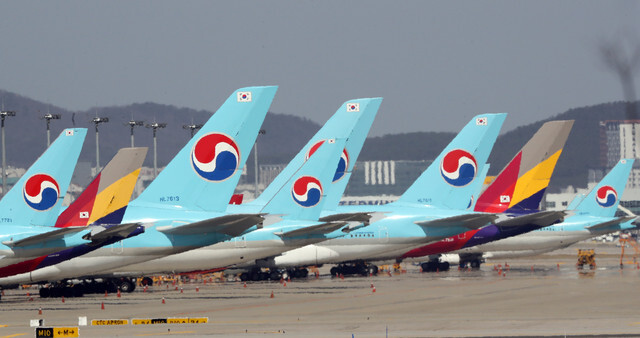hankyoreh
Links to other country sites 다른 나라 사이트 링크
All travelers arriving from overseas to be checked for fever starting Mar. 30

Starting on Mar. 30, anyone wishing to fly into South Korea will be checked for fever and won’t be allowed to board if their temperature is above 37.5 degrees Celsius.
During a meeting of the Central Disaster and Safety Countermeasures Headquarters on Mar. 27, South Korea’s Ministry of Land, Infrastructure, and Transport (MOLIT) reported that passengers on all flights entering South Korea would be checked for fever by the airline at the boarding gate before departure and would not be allowed to board if their temperature exceeds 37.5 degrees. Airlines will refund passengers who are refused boarding. This measure will apply to all flights into the country, operated by both domestic and foreign airlines, starting with flights arriving after Mar. 30, 12:00 am. With that in mind, MOLIT has sent official requests for cooperation to all airlines providing service into the country and has sent electronic announcements to aviation officials around the world.
The government has adopted these measures because of growing concerns that the ongoing outbreak of COVID-19 in South Korea will be aggravated by the influx of infections from abroad. The authorities recorded 91 new cases of COVID-19 on Friday, bringing the total number of cases to 9,332; 19 of the newly diagnosed individuals (20.9%) had entered the country from overseas. All 19 are Korean nationals; 13 were diagnosed in quarantine at the airport, while the other six were not diagnosed until returning home. Europe was the region of origin for the largest number, at 11; seven had arrived from the Americas, and one from Asia (not including China).
Questionable effectiveness of entry ban on all foreignersSome groups continue to push for an entry ban on foreigners, but the government remains firmly opposed to that idea. “Considering that South Korean citizens account for 90% of infected individuals arriving from overseas, we’re limited in our ability to adopt measures such as immediately banning entry to the country. We’ll be strictly following the current system, which is focused on mandatory self-quarantine,” said Prime Minister Chung Sye-kyun during the meeting of the disaster safety headquarters. Since non-Koreans only represent 31 (0.33%) of the total 9,332 confirmed cases in the country, there are doubts about whether an entry ban would even be effective.
South Korea’s public health authorities have decided to actively recommend that people placed under self-quarantine after arriving from Europe or the US use personal vehicles when traveling to their place of residence. Those who don’t have access to their own vehicle are being provided designated buses and carriages on the KTX express train, though they’ll have to pay their own way. Starting on Mar. 28, people in transit to the capital region for self-quarantine can ride a designated shuttle bus from the airport. Those bound for other regions can take that bus to Gwangmyeong Station and then transfer to dedicated KTX carriages en route to the station closest to home. Local governments are planning to provide transportation for the last leg of their journey.
In a related story, the South Korean government is considering the option of having the open-air screening centers outside Incheon Airport, which are currently testing people arriving from Europe without symptoms, also test people with symptoms. Such people have previously had their samples collected at the quarantine center inside the airport, but as the waiting period gets longer, concerns have been raised about the possibility of cross infection.
By Park Hyun-jung, Noh Ji-won, and Lee Wan, staff reporters
Please direct comments or questions to [english@hani.co.kr]

Editorial・opinion
![[Column] Season 2 of special prosecutor probe may be coming to Korea soon [Column] Season 2 of special prosecutor probe may be coming to Korea soon](https://flexible.img.hani.co.kr/flexible/normal/500/300/imgdb/original/2024/0426/3317141030699447.jpg) [Column] Season 2 of special prosecutor probe may be coming to Korea soon
[Column] Season 2 of special prosecutor probe may be coming to Korea soon![[Column] Park Geun-hye déjà vu in Yoon Suk-yeol [Column] Park Geun-hye déjà vu in Yoon Suk-yeol](https://flexible.img.hani.co.kr/flexible/normal/500/300/imgdb/original/2024/0424/651713945113788.jpg) [Column] Park Geun-hye déjà vu in Yoon Suk-yeol
[Column] Park Geun-hye déjà vu in Yoon Suk-yeol- [Editorial] New weight of N. Korea’s nuclear threats makes dialogue all the more urgent
- [Guest essay] The real reason Korea’s new right wants to dub Rhee a founding father
- [Column] ‘Choson’: Is it time we start referring to N. Korea in its own terms?
- [Editorial] Japan’s rewriting of history with Korea has gone too far
- [Column] The president’s questionable capacity for dialogue
- [Column] Are chaebol firms just pizza pies for families to divvy up as they please?
- [Column] Has Korea, too, crossed the Rubicon on China?
- [Correspondent’s column] In Japan’s alliance with US, echoes of its past alliances with UK
Most viewed articles
- 1After election rout, Yoon’s left with 3 choices for dealing with the opposition
- 2Two factors that’ll decide if Korea’s economy keeps on its upward trend
- 3Why Kim Jong-un is scrapping the term ‘Day of the Sun’ and toning down fanfare for predecessors
- 4Noting shared ‘values,’ Korea hints at passport-free travel with Japan
- 5AI is catching up with humans at a ‘shocking’ rate
- 6South Korea officially an aged society just 17 years after becoming aging society
- 7Korea’s 1.3% growth in Q1 signals ‘textbook’ return to growth, says government
- 8‘We must say no’: Seoul defense chief on Korean, USFK involvement in hypothetical Taiwan crisis
- 9Exchange rate, oil prices, inflation: Can Korea overcome an economic triple whammy?
- 10Japan officially says compensation of Korean forced laborers isn’t its responsibility